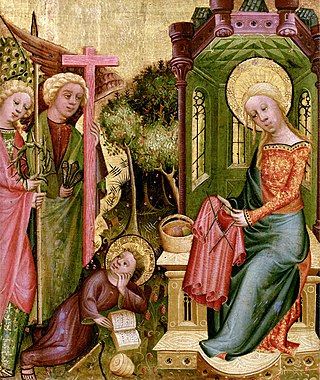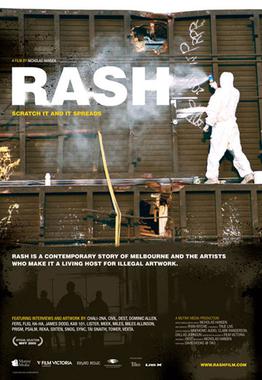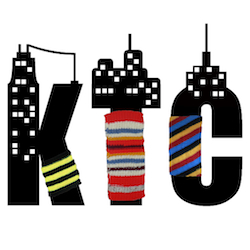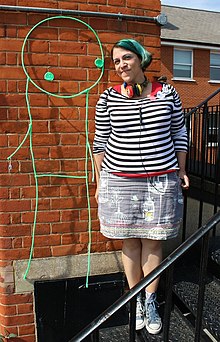
Crochet is a process of creating textiles by using a crochet hook to interlock loops of yarn, thread, or strands of other materials. The name is derived from the French term crochet, meaning 'hook'. Hooks can be made from a variety of materials, such as metal, wood, bamboo, or plastic. The key difference between crochet and knitting, beyond the implements used for their production, is that each stitch in crochet is completed before the next one is begun, while knitting keeps many stitches open at a time. Some variant forms of crochet, such as Tunisian crochet and broomstick lace, do keep multiple crochet stitches open at a time.

Knitting is a method for production of textile fabrics by interlacing yarn loops with loops of the same or other yarns. It is used to create many types of garments. Knitting may be done by hand or by machine.

The Aran jumper is a style of jumper that takes its name from the Aran Islands off the west coast of Ireland. A traditional Aran Jumper usually is off-white in colour, with cable patterns on the body and sleeves. Originally the jumpers were knitted using unscoured wool that retained its natural oils (lanolin) which made the garments water-resistant and meant they remained wearable even when wet.

Knitting is the process of using two or more needles to pull and loop yarn into a series of interconnected loops in order to create a finished garment or some other type of fabric. The word is derived from knot, thought to originate from the Dutch verb knutten, which is similar to the Old English cnyttan, "to knot". Its origins lie in the basic human need for clothing for protection against the elements. More recently, hand knitting has become less a necessary skill and more of a hobby.

Nålebinding is a fabric creation technique predating both knitting and crochet. Also known in English as "knotless netting", "knotless knitting", or "single-needle knitting", the technique is distinct from crochet in that it involves passing the full length of the working thread through each loop, unlike crochet where the work is formed only of loops, never involving the free end. It also differs from knitting in that lengths must be pieced together during the process of nålebinding, rather than a continuous strand of yarn that can easily be pulled out. Archaeological specimens of fabric made by nålebinding can be difficult to distinguish from knitted fabric.

Craftivism is a form of activism, typically incorporating elements of anti-capitalism, environmentalism, solidarity, or third-wave feminism, that is centered on practices of craft - or what has traditionally been referred to as "domestic arts". Craftivism includes, but is not limited to, various forms of needlework including yarn-bombing or cross-stitch. Craftivism is a social process of collective empowerment, action, expression and negotiation. In craftivism, engaging in the social and critical discourse around the work is central to its production and dissemination. Practitioners are known as craftivists. The word 'craftivism' is a portmanteau of the words craft and activism.

Rash, written RASH, is a 2005 Australian documentary film, directed by Nicholas Hansen. Its subject is contemporary urban Australia and the artists who are making it a host for illegal street art. With the tagline 'Scratch it and it spreads', Rash explores the cultural value of unsanctioned public art and the ways that street art and graffiti contribute to public dialogue.

Knitted fabric is a textile that results from knitting, the process of inter-looping of yarns or inter-meshing of loops. Its properties are distinct from woven fabric in that it is more flexible and can be more readily constructed into smaller pieces, making it ideal for socks and hats.

The UK Hand Knitting Association (UKHKA) is a not-for-profit British organisation dedicated to promoting hand knitting in the UK. Through a variety of initiatives and the assistance of a nationwide network of volunteers who pass on their skills, the UKHKA focus on ensuring a vibrant future for all aspects of yarn crafts.

Stitch London is a knitting group in London, England, who meet weekly in various venues across central London to knit in public. It is also a virtual knitting group whose members join via newsletter, Facebook, Ravelry, and Twitter. Its members number in their thousands and it has a global membership despite being based in London.
Knitting clubs are a feature of the 21st-century revival of hand knitting which began in America and has spread to most of Europe. Despite the name, knitting clubs are not limited to knitting; both crochet-centered and knit-centered clubs are collectively called "knitting clubs." While knitting has never gone away completely, this latest reincarnation is less about the make-do and mend of the 1940s and 1950s, and more about making a statement about individuality and developing a sense of community.

Knitta Please, also known as simply Knitta, is the group of artists who began the "knit graffiti" movement in Houston, Texas in 2005. They are known for wrapping public architecture—e.g. lampposts, parking meters, telephone poles, and signage—with knitted or crocheted material, a process known as "knit graffiti", "yarn storming" or "yarnbombing". The mission is to make street art "a little more warm and fuzzy."
Hand knitting is a form of knitting, in which the knitted fabric is produced by hand using needles.
I Knit London is a knitting organisation based in London, England, UK, comprising a knitting group, knitting shop and knitting events. I Knit London was formed in December 2005, and is run, by Gerard Allt and Craig Carruthers.

Yarn bombing is a type of graffiti or street art that employs colourful displays of knitted or crocheted yarn or fibre rather than paint or chalk. It is also called wool bombing, yarn storming, guerrilla knitting, kniffiti, urban knitting, or graffiti knitting.

Knit the City is a group of "graffiti knitting and crochet" street artists founded in London, England in 2009. The collective is credited with being the first to go beyond the simple 'cosies' of early graffiti knitting to tell 'stitched stories', using knitted and crochet amigurumi creatures and objects in their public installations. This practice has been taken up by groups internationally.

Illusion knitting or shadow knitting is a form of textile art, in which the knitting is viewed as simply narrow stripes from one angle, and as an image when viewed from another angle. Illusion knitting has been recognised as an art form since 2010, largely due to the advances made by Steve Plummer who has created several large and detailed pieces. Similar effects occur in Tunisian crochet.
Kate Just is an American-born Australian feminist artist. Just is best known for her inventive and political use of knitting, both in sculptural and pictorial form. In addition to her solo practice, Just often works socially and collaboratively within communities to create large scale, public art projects that tackle significant social issues including sexual harassment and violence against women.

The Tempestry Project is a collaborative fiber arts project that presents global warming data in visual form through knitted or crocheted artwork. The project is part of a larger "data art" movement and the developing field of climate change art, which seeks to exploit the human tendency to value personal experience over data by creating accessible experiential representations of the data.
Kirk Andrew Dunn is an actor, writer, and fibre artist best known for his use of texture and colour in knitting, and most particularly, for the giant triptych installation, "Stitched Glass," and the one-man show he co-wrote and tours about that work, The Knitting Pilgrim.
















